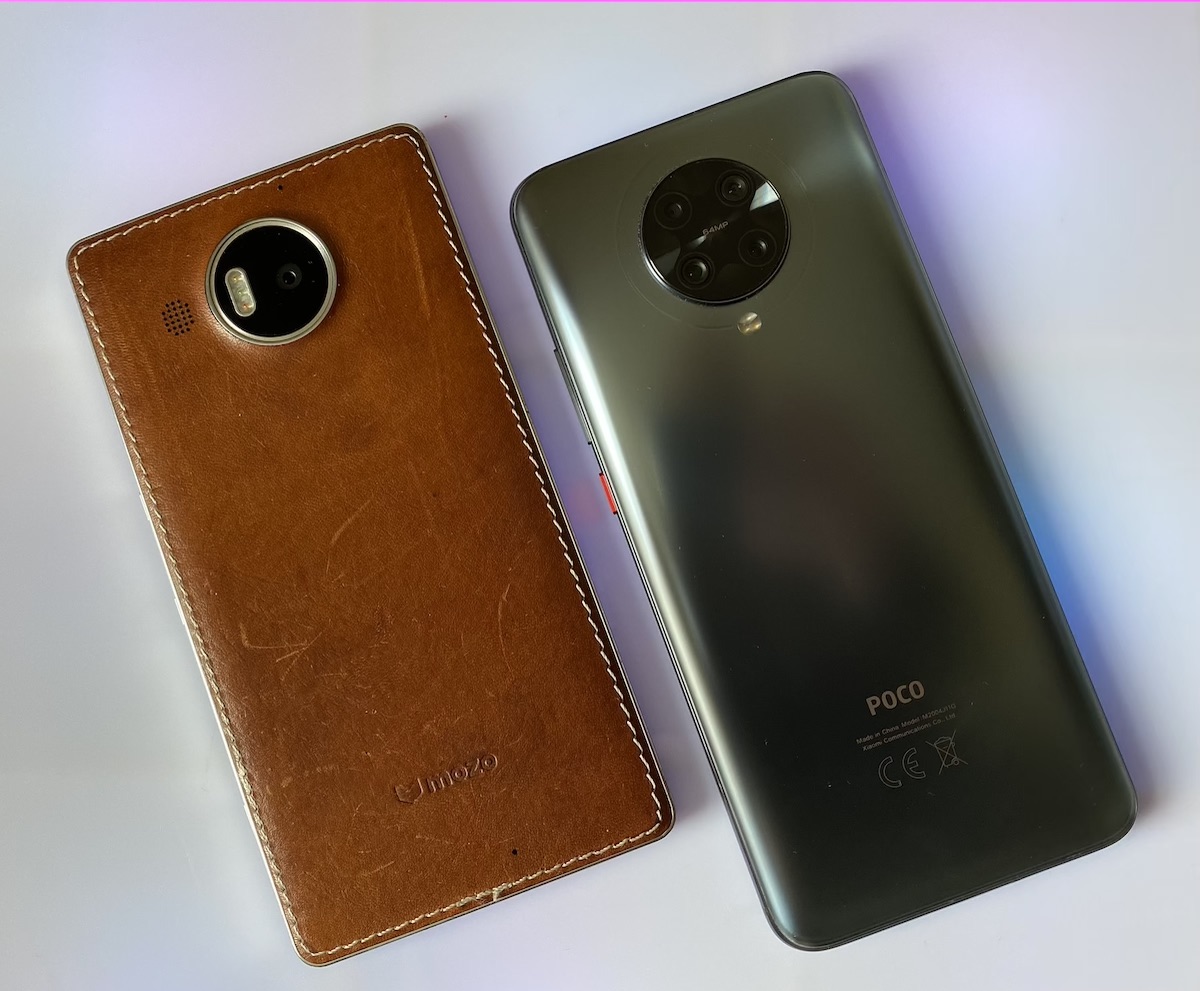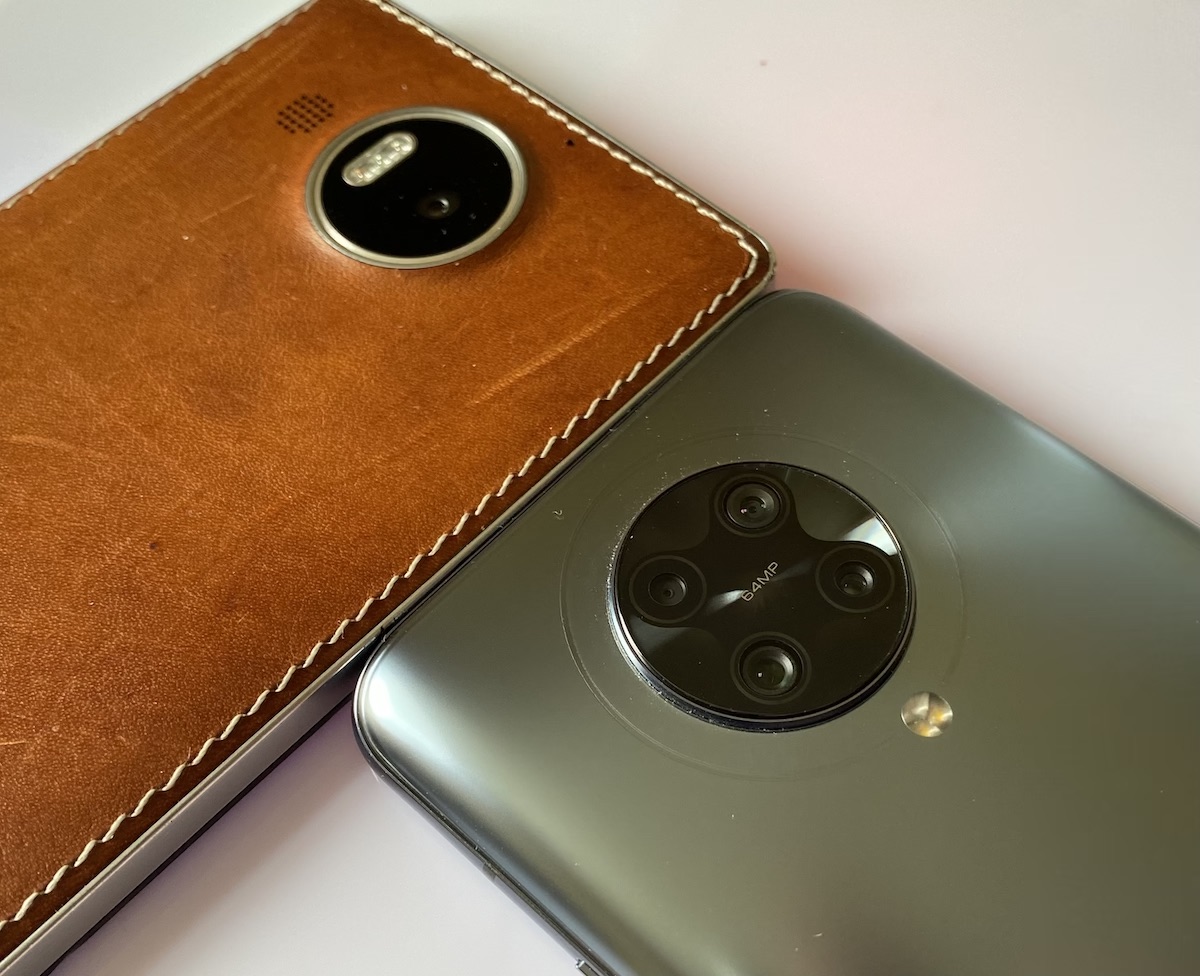
Lumia 950 XL and POCO F2 Pro...

As usual, just for fun and curiosity, I've shaded in green an obvious 'win' for either device. Any row where a winner would be totally subjective is left uncoloured. Or, where all devices are utterly excellent but in different ways, I've given each a 'green'(!)
[By the way, if you're viewing this feature on a phone then the table may well cause you problems. Try viewing in landscape mode? Failing that, go view this on a laptop or tablet!]
| Microsoft Lumia 950 XL | (Xiaomi) POCO F2 Pro | |
| Date first available | November 2015 | June 2020 |
| Current price, availability | No longer officially for sale, though it's often on clearance prices if you're lucky and at outrageous profiteering prices due to rarity (if you're not!) | Just over £500 as I write this, but there's a question mark over official UK availability. There was talk of a £450-ish launch later in June 2020. In this ballpark, anyway! |
| Dimensions, form factor, weight |
152 x 78 x 8mm, plastic chassis and replaceable backs (plastic/leather/wood etc, from Mozo, as modelled here!), 165g, bezels are comparatively small |
163 x 75 x 9mm, 219g, taller and narrower. Heavy, but reassuringly so. Metal frame with matt glass back (though despite this, Qi is missing - see below). Supplied with an excellent clear TPU case. Gets the win here on amount of display available per 'size in the hand'. |
| Durability | No specific durability metrics, though the fact that the back comes off will help enormously for water damage, i.e. taking out battery and cards immediately, drying out the internals, even unscrewing the motherboard from the guts of the phone. I'm old-school here! All damage to the back or corners is trivial through replacement of the rear, but the screen's exposed, of course. The plastics used should absorb shock and, anecdotally, I've never bothered putting a case on any Lumia. Just saying. I think that fact is significant. |
No IP rating and tests have shown that this definitely isn't dust and waterproof. Props for the in-box clear case though. Plus the Lumia's parts aren't always available anymore, which has to be partly taken into consideration. |
| Operating system, interface | Windows 10 Mobile, (dismissable) virtual controls, as needed, now officially updated to W10 Fall Creators Update (Redstone 3, Autumn 2017) with security to 'January 2020'. |
Android 10, April 2020 security, MI UI 11 skin, gesture controls available, or navigation buttons on-screen (the default). A fairly standard skinned Google interface throughout, though with plenty of Xiaomi first party applications in addition to the Google core titles. By default Mi UI 11 now presents an 'app drawer' as standard, so you don't have to live with everything on your home screens. |
| Display |
5.7" AMOLED (1440p at 16:9 aspect ratio, matching most video media), Gorilla Glass 4, ClearBlack Display polarisers help with outdoor contrast, excellent viewing angles. Screen area is approximately 88 cm2 Glance screen available (in various colours) for always-on time, day and notification icons, plus some detailed info from a specified app. |
6.7" 1080p Super AMOLED, 20:9 ratio, Gorilla glass 5, screen area is roughly 107cm2 Also excellent and pretty good outdoors in the sun. There's a graphical 'Always on' 'Glance' display with time, date and color notifications (off by default, but trivial to toggle on). It's quite dim after some brighter initial minutes, presumably to save power, but it's there and it works. |
| Connectivity |
LTE, NFC (all uses), Wi-Fi b/g/n/ac, integral wifi tethering, Bluetooth 4.2 (all uses). Continuum connectivity to use a wide range of first and third party UWP apps on external displays as secondary screen, independent of the phone display. Includes the new NexDock 2, transforming the Lumia into a Windows 10 S laptop, effectively. |
LTE, 5G, NFC (all uses), Wi-Fi b/g/n/ac/6, integral wifi tethering, Bluetooth 5.1 (all uses). |
| Processor, performance | Snapdragon 810 chipset, 3GB RAM, faster than it's ever been now on the Fall Creators Update though still slower for almost everything than on the Android phone. Multi tasking and app resumption is excellent though, at least with all the modern UWP apps |
Snapdragon 865, 6GB (or 8GB) RAM, lightning fast at everything |
| Capacity | 32GB internal storage, expandable via (cheap) microSD to extra 256GB | 128GB (or 256GB), no expansion. No microSD is a black mark, but then again surely 256GB is more than enough for almost everyone in 2020? |
| Imaging (stills) |
20MP PureView f/1.9 1/2.4" BSI sensor, Phase Detection auto-focus, dedicated camera shutter button and launch key, 1.5x lossless digital zoom (in 8MP oversampled mode, and lossy digital after that), OIS. 'Rich Capture' produces customisable HDR shots and 'dynamic flash', with triple LED illumination. Outstanding shots in most light conditions, with just focussing issues in low light as an Achilles heel. |
Main camera: 64 MP, f/1.9, 1/1.72", PDAF An imaging head to head is next, don't worry. Xiaomi (sorry, POCO) hasn't really gone all out in the imaging department - that 5MP 2x telephoto is strictly for sub-10cm macros though, there's no telephoto for landscapes. I've given the win to the Lumia as I can't imagine this POCO phone will triumph, but I'll revisit this score if I'm wrong! |
| Imaging (front/selfie) |
5MP front camera | 20MP, f/2.2, motorised (slides out of the top) |
| Imaging (video) | Up to 4K, optically (and optionally digitally) stabilised, with 'Best photo' 8MP grabbing built-in, plus Rich Recording and HAAC microphones for high quality, gig-level stereo capture. | Up to 4K video capture, with EIS, high quality stereo audio capture. |
| Music and Multimedia (speakers) |
A tinny mono speaker by modern standards, though as ever you can trade volume for fidelity in a simple tweak on Lumias. | Loudish mono speaker at the bottom, no great fidelity or bass. But worlds better than the 950 XL's tiny (and tinny) monstrosity! |
| Music (headphones) |
3.5mm headphone jack, A2DP+AptX, plus a decent internal DAC, so great wired and wireless headphone audio too. | 3.5mm headphone jack, A2DP, AptX, AptX HD, all very similar in quality to the Lumia. The specs advertise 24-bit audio, but the DAC is just the Snapdragon 865's, so in practice it's not stunning, i.e. there's no dedicated DAC or power amp. |
| Navigation |
Windows 10 Maps is now pretty mature and impressive, especially once you've learned the live traffic routine trick! Offline maps save a lot of data bandwidth for those on tight contracts or anyone in a low signal (data) area. But it's all looking a little neglected in 2020 compared to the bells and whistles in Google Maps. |
Google Maps is now the gold standard in phone navigation, tied in with many other Google services and offering true real time navigation around traffic issues, even at local level, along with offline maps that auto-update. |
| Cortana/Voice | Cortana was in theory now mature and well integrated, though functionality has been falling away and most attempts to rouse her end in failure in 2020. | Google Assistant is baked in and works well, far superior to the dying Cortana in 2020, due to the investment that Google has put in over the last few years. |
| Battery, life | Removable 3000mAh battery, and the ability to change cells are a positive here (and you CAN still buy decent spare batteries), plus USB Type C Power Delivery (up to 3A, so 15W) and 1A Qi wireless charging built-in also helps. However, a Lumia running Windows 10 Mobile will now discharge in 24 hours even if you don't use it much. |
Sealed 4700mAh battery, gets easily through a day, with charge to spare. Type C port supports 30W wired charging via Power Delivery standard or Quick Charge 4.0+. There's no Qi wireless charging though, which is disappointing for something with these ambitions, and gives the Lumia the narrow win. |
| Cloud aids | Windows Photos syncs at full resolution and quality across all signed-in devices, subject to your OneDrive tariff (stingy, unless you have Office 365 - most of us do), should you have thousands of images in the system. Plus Windows 10 backs all your media, application data and settings to a separate backup folder system, tariff-free on OneDrive, for easy restoration on a new or factory reset phone. | Google Photos does a great job of organising photos and syncing them across all signed-in phones and tablets, albeit at 'reduced' quality (re-compression server-side). |
| File compatibility | As with all Windows phones, plugging into a Windows PC gives full drag and drop to the phone's user file system. Plugging into a Mac is more problematic, though seems to work under Catalina. | Plugging into any PC gives immediate MTP file access, plus this works on a Mac on all OS versions, with Google's Android File Transfer utility, for drag and drop of all user files. Seamless and lightning fast. |
| Biometrics | Iris recognition ('Windows Hello') works well unless you wear varifocals(!), but takes a couple of seconds (including an animation!) in real world use. There's also no official way of paying in shops using this. |
An in-screen fingerprint sensor is optical and is foolproof and reliable, unlocking in under a second. Works to authenticate transactions too, as you'd expect, with Google Pay or in the Play Store. Face unlock is also present for convenience sake - and works well, but it's not secure enough for finances and purchases. |
| Applications and ecosystem | Windows 10 Mobile had most (though not all) mainstream apps and services covered, though some are dropping away now - see my guide! Often third party clients are involved, mind you, there are companies who hate Microsoft so much that they simply refuse to write for Windows, it seems. And 'long tail' niche/boutique apps are hard to find for real world companies and shops. |
The might of Google and Android's app ecosystem - everything is available and almost always in first party form. |
| Upgrades and future | Windows 10 Mobile is now effectively out of support. From now on, it will be useable but with more and more service caveats applying. Still, 'end 2019' was a full four years since the Lumia 950 XL was launched, so it's hard to complain. | POCO (sorry, err.... Xiaomi) has a chequered history of updates, but the company seems keen to make a dent in the West now so let's assume that this will get good support through 2020 and 2021. |
Verdict
Adding up the green 'wins' (for fun?!) gives a 13-5 win to the much newer device, which is about as expected. The POCO F2 Pro's biggest USP is the performance ratio to its price. This is about as fast and as futureproof as you can get for under £500. It doesn't come as a surprise then to find out that some corners have been cut here and there - the camera system isn't very ambitious, there are no stereo speaker, the display's flat (though many like this), and there's no wireless charging. But you can't really fault the overall value for money for an Android flagship.
I'll have an imaging comparison up very shortly, using examples from both the default Xiaomi Camera app and Google's GCam, by way of a third party port.

